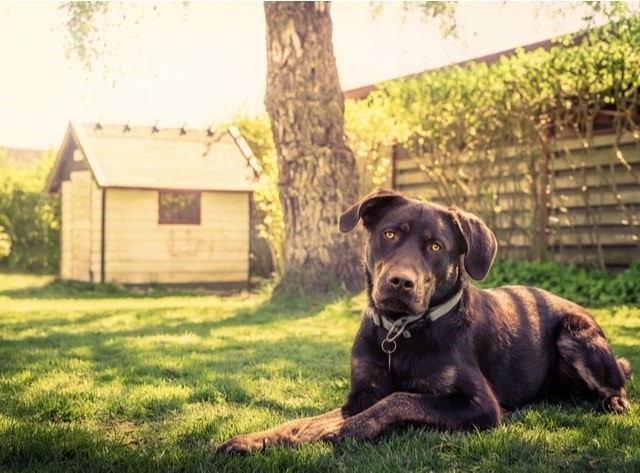It is natural for dogs to be outside, and most dogs love the outdoors. There are several reasons that some dog owners might want to keep a dog outside. Perhaps they want a guard dog or have a dog with behavioral issues. But is it cruel to keep a dog outside for extended periods of time? This is a hotly debated topic amongst animal welfare experts and can be considered animal cruelty if an animal is left alone without shelter, food, and water.1 In general, the risks of keeping your dog outside far outweigh any potential benefit.
1. Evaluate Your Reasons for Keeping a Dog Outside
When considering keeping a dog outside, first evaluate your reasons why you think your dog needs to be kept outside. Does your dog bark too much?2 Shed too much?3 Is your dog showing destructive behavior?4 Does someone in the household have allergies to the dog? Truthfully, none of these are legitimate reasons to keep a dog outside.
Before getting a dog, you should think carefully about how to handle some of these issues that could arise.5 For dogs showing unwanted behaviors, you should invest the time to implement behavior modification techniques to correct the behaviors.6 Remember that dog trainers and veterinary behavior specialists exist to help you work through these issues with your dog.
2. Consider Exposure to the Elements
Most areas of the country experience extreme weather. Whether extreme heat or extreme cold, these elements pose a significant health risk to your dog. Dogs do not regulate temperature the same way that humans do. Heat exhaustion and heat stroke are common problems that dogs might experience from prolonged exposure to heat, with heat stroke being potentially deadly.7 Increased risk factors include: outdoor temperatures over 80°F, exposure to direct sunlight, dogs with long coats, and brachycephalic breeds (smush-face dogs).8 On the flip side, exposure to prolonged cold temperatures can result in hypothermia (low body temperature), frostbite, or even death.910
While some dogs are bred for colder weather, like Huskies and Alaskan Malamutes, dogs with thinner hair coats may become uncomfortable when temperatures drop below 45°F. Aside from exposure to extreme temperatures, you also run the risk of exposing your dog to thunderstorms, snowstorms, or even tornadoes. Not only is an outdoor dog shelter insufficient for these types of extreme weather, but your dog is likely to be alone and frightened during this time.
3. Think About Basic Human Needs. Dogs Need Them Too!
The basic human needs for humans are food, water, and shelter. Your dog’s basic needs are actually quite similar! Keeping a dog outside could potentially deprive them of all these basic needs, depending on the length of time they are kept outdoors. Although you may think it is natural for a dog to live outside, remember that an outdoor shelter likely won’t compare to the safety of keeping your dog indoors.
4. Remember That Dogs are Social Creatures
Dogs are social creatures and need social interaction and companionship, just like we do! By keeping a dog outside, you risk depriving them of their social needs, which can be significantly detrimental to their health.11 Isolation and a lack of interaction could lead to separation anxiety, worsened destructive behaviors, or even aggression.12 If your dog is suffering from a behavioral issue, keeping them outside is not the answer and could worsen the problem.
5. Understand the Risks
Aside from exposure to the outdoor elements, there are significant other risks you run by keeping a dog outside. Smaller dogs can easily be injured by other animals, such as raccoons, coyotes, and hawks. If the outdoor area isn’t well-secured, other dogs could enter the yard and cause a fight. You also run the risk of your dog escaping the outdoor area and getting hit by a car or lost. There may be objects kept outdoors that pose a risk of physical injury, such as sharp metal scraps, wood scraps, glass, etc. Prolonged unsupervised access to the outdoors also means potential access to plants that are toxic to dogs, poisonous mushrooms, and rocks and stones that your dog might ingest.13 Lastly, consider household items that may be stored in a garage or outdoor space that are toxic if ingested by your dog, such as rat poison, antifreeze, and slug bait.14 The risks of keeping a dog outside are significant, with many of them resulting in potential death.
If You Absolutely Have to Keep Your Dog Outside, Do it the Right Way
Keeping a dog outside all the time can be considered animal cruelty particularly if it’s too cold for your dog to sleep outside. It’s recommended to exhaust all other options before leaving a dog outside for prolonged periods of time. Ideally, your dog should still have free access to the indoors by installing a doggy door. If you absolutely must keep a dog outside, you need to take the appropriate precautions to ensure that your dog is safe and that its basic needs are being met.
An outdoor dog kennel for all types of weather is essential, as well as an outdoor dog bed with a canopy (or potentially an outdoor elevated dog bed with a canopy or an outdoor bed that’s also a waterproof dog bed). For warm weather, you must be sure that your dog has access to enough shade to keep them out of direct sunlight and a shelter with adequate ventilation and watch for signs your dog is overheated. You may also want to consider a cooling mat for your dog. For cold weather, an insulated dog shelter will be required. You will need to monitor their food and water bowls at least twice daily. In warmer climates, it is recommended that your dog have access to multiple water bowls. In colder climates, you will need to make sure the water bowls don’t freeze!
The outdoor area should be dog-proofed, meaning that you will need to check for and remove any potentially hazardous household items and toxic plants. You must ensure that the area is fenced and secured so that unwanted wildlife and other animals cannot enter the space and that your dog cannot accidentally escape. You will still need to provide adequate enrichment and social interaction for your dog, too. All in all, there could be serious health risks (including death) for keeping your dog outside and if done incorrectly, you could run the risk of being charged with animal neglect or animal cruelty.15
Article Sources
Pet News Daily uses only high-quality sources, including peer-reviewed studies, to support the facts within our articles. Read our editorial process to learn more about how we fact-check and keep our content accurate, reliable, and trustworthy.
- The Humane Society of the United States. What to do if you see a pet left out in the cold. Humanesociety.org. Accessed December 1, 2021.
- The Humane Society of the United States. How to get your dog to stop barking. Humanesociety.org. Accessed December 1, 2021.
- Shaughney M. 6 Tips to Control Dog Shedding. Akcpetinsurance.com. Published January 29, 2019. Accessed December 1, 2021.
- ASPCA. Destructive Chewing. Aspca.org. Accessed December 1, 2021.
- PetsPyjamas. 10 Things You Need to Know Before Getting a Dog. Petspyjamas.com. Updated September 11, 2021. Accessed December 1, 2021.
- AAHA. Changing behaviors. Aaha.org. Accessed December 1, 2021.
- Oliver E. A Summer Guide to Heat Stress and Heat Stroke for Dog Owners. Emergency-vets.com. Published June 23, 2020. Accessed December 1, 2021.
- Bauhaus JM. All About Brachycephalic Dogs. Hillspet.com. Published May 21, 2018. Accessed December 1, 2021.
- Coates J. Dog Hypothermia. Petmd.com. Published October 20, 2021. Accessed December 1, 2021.
- Hunter T, Ward E. Frostbite in Dogs. Vcahospitals.com. Accessed December 1, 2021.
- Jones CL. Social well-being for dogs. Animalwellnessmagazine.com. Published September 14, 2015. Accessed December 1, 2021.
- ASPCA. Separation Anxiety. Aspca.org. Accessed December 1, 2021.
- ASPCA. Poisonous Plants. Aspca.org. Accessed December 1, 2021.
- Andrews J. Top 11 Common Household Items Toxic to Dogs. Felcana.com. Published December 21, 2020. Updated February 2, 2021. Accessed December 1, 2021.
- Randolph M. Animal Cruelty and Neglect. Nolo.com. Accessed December 1, 2021.


